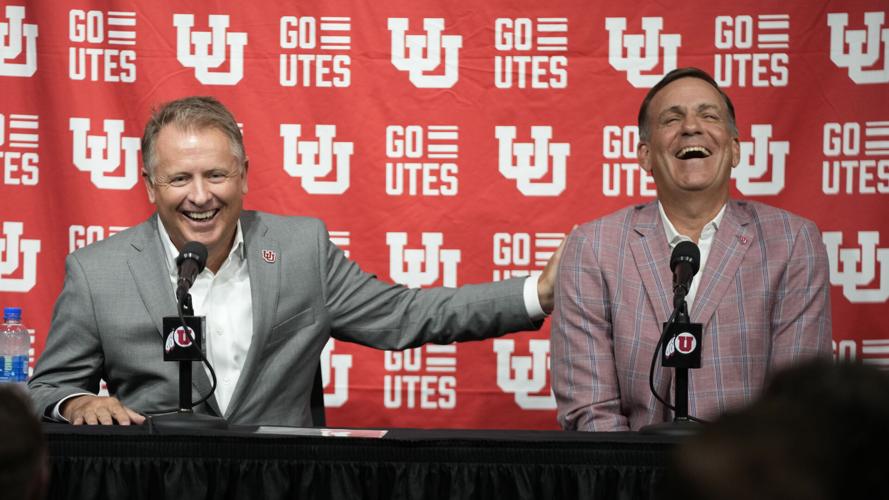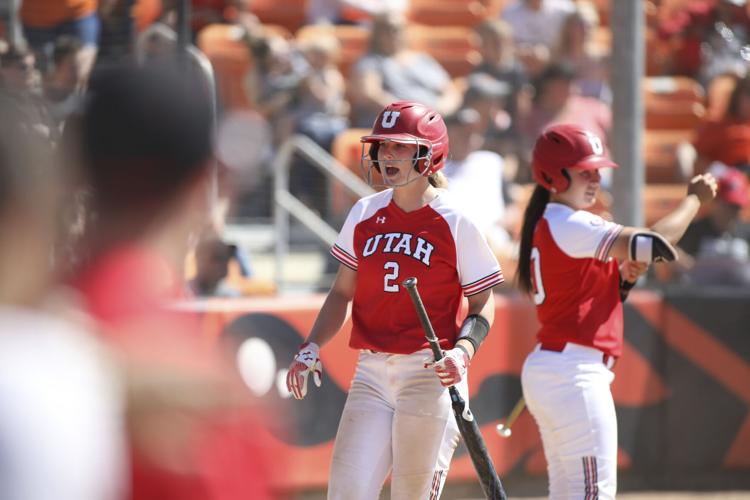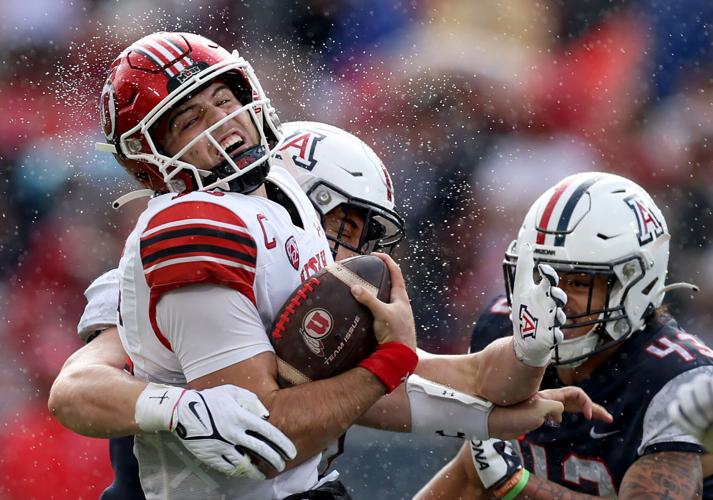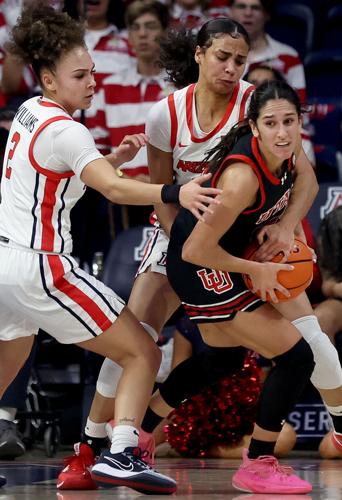(Editor’s note: This is part of the Star’s month-long “Big 12 Blitz” series, where we introduce (or in this case, reintroduce) U of A fans to the on- and off-field need-to-know details surrounding each member of the 16-team Big 12. Today: The University of Utah, located in Salt Lake City.)
The Star's Big 12 Blitz is presented by Tucson Appliance Company.

Tucson Appliance Company has something for everyone! We specialize in new, reconditioned, scratch-and-dent, and high-end appliances. Known for…

Greg Hansen is the longtime sports columnist for the Arizona Daily Star and Tucson.com.
After 100 years of sports competition, 1924-2024, Arizona and Utah have never been more closely matched. In the just-completed Learfield Director’s Cup final standings, Utah ranked No. 47 and Arizona No. 48.
That belies the sometimes crazy up-and-down nature of the Utah vs. Arizona rivalry in all sports, one that began exactly a century ago when it required a 50-hour train excursion for the Wildcats to get to Salt Lake City.

Utah, having reached 16 bowl games in Kyle Whittingham’s 19 seasons as the Utes’ head coach, has had a clear upper-hand over Arizona in football prowess over the past two decades. But last year, Arizona turned the tables a bit, blowing out Utah 42-18 on Nov. 18, 2023, at Arizona Stadium as part of the Wildcats’ 10-win campaign. Utah was playing with the serviceable Bryson Barnes (left front) at quarterback for much of the season; but as star Cam Rising returns from injury in 2024, the Utes are expected to contend for a conference championship alongside Arizona and others in their first Big 12 season.
As you might imagine, the unpredictability of the Utes-Wildcats series, now moving to the Big 12 conference, could make a compelling TV documentary.

The universities of Arizona and Utah have been competing athletically — including on the gridiron for the past 100 years. The schools were even both part of the WAC in the 1960s and ’70s. But now as much as ever, as the teams join the Big 12 together, the programs “have never been more closely matched” across sports, writes Star columnist Greg Hansen.
It began with great anticipation.
Some in the college football community jumped the gun when Utah and Arizona established their football competition 100 years ago: Oct. 18, 1924, at Cummings Field in Salt Lake City.
“Today, the big guns in the football world start firing in earnest,’’ the Daily Star reported. “Of more than ordinary interest to the entire west is the game between the Wildcats and University of Utah.’’
Big guns? A year earlier Arizona’s schedule included Phoenix JC and the Phoenix Indians. Utah played Whitman College and Albertsons College.
“The invasion of the Mountain states marks the opening of a new era in Arizona football history,’’ the Star reported, referring to the inaugural Utah-Arizona game, any sport, as “a big tussle.’’
Unlike today’s 90-plus-minute flight to Salt Lake City, it was a long and tedious journey in 1924; the Wildcats required 50 hours via train, a not-so-direct route that went through Colton, California. By the time coach Pop McKale’s team arrived in SLC, they were exhausted, losing 32-6.
It would be 17 years (and four more Utah victories) before Arizona was competitive against the Utes (then referred to as Crimson and Red Devils). Finally, on Dec. 6, 1941 — a day before the Japanese attacked Pearl Harbor — the Wildcats became competitive.
A capacity crowd of 8,500 filled Arizona Stadium. The Star proclaimed that the game would “decide the football championship of the vast Mountain-area, ranging from Canada to the Mexican border.’’
Arizona was No. 2 in the nation in total offense (361 yards per game) and Utah was third (354 yards).

University of Utah President Taylor Randall, left, and athletic director Mark Harlan share a laugh during a news conference in Salt Lake City on Aug. 7, 2023, while addressing the school’s from the Pac-12 to the Big 12. Harlan, a University of Arizona alum and former UA assistant AD, was hired to the top spot in the Utah athletic department in 2018.
So, of course, it was a defensive struggle. Utah prevailed 12-6 when Arizona couldn’t score from the Utah 8-yard line with 58 seconds remaining.
Utah owned the Wildcats in football, going 9-1-2 against Arizona in the rivalry’s first 12 games, until, finally, in 1962, the Utes and Wildcats joined forces in the new Western Athletic Conference. Before that, Arizona had played in the Border Conference, while Utah jumped from the Rocky Mountain Conference to the Skyline Conference.
Their relationship was temporary. Sixteen years later, Arizona jumped to the Pac-10. It wasn’t until 2011 that they came together again in the Pac-12.
After all those moves, across 100 years and 48 football games, one thing stands tall: Utah twice won the Pac-12 and played in the Rose Bowl. Arizona? Nada. It might be the most heartbreaking statistic in UA football history.
In that regard, the Utes have been something of Heartbreaker U to Arizona fans. Perhaps the most hurtful loss in Arizona basketball history was a 1998 Elite Eight game in Anaheim when the Utes stomped on the No. 1 seed Wildcats, routing the defending national champions 76-51.

Utah’s Ellessa Bonstrom celebrates after scoring a run during a matchup against Oregon State in May 2019 in Corvallis, Oregon. Bonstrom, a Tucson native and Canyon del Oro grad, was a multiple-year All-American for the Utes, helping lead Utah to the 2023 Women’s College World Series — the program’s first appearance at college softball’s championship showcase in almost three decades.
“It’s a game I’ll never forget,’’ UA center A.J. Bramlett said in the sad Wildcat locker room that day. “If we played them 10 times, we’d win nine.’’
There was no rematch.
Utah also was quick to grab the historical advantage in its basketball rivalry with Arizona. Starting in 1953, the Utes (then referred to as the Redskins) won their first eight games against Arizona. One of those games remains a lasting stain in the Arizona record book.
In December 1955, at the old Einar Nielsen Fieldhouse in SLC, Utah beat Arizona 119-45, which remains the largest deficit in Arizona basketball history. The Utes, who would play in the 1961 and 1966 Final Fours under coach Jack Gardner, took a 44-8 lead that night.
And even though Arizona has dominated the rivalry the last 50 years, the losses of 1955 and 1998 are likely to carry some weight in the basketball record books for another 100 years.

The women’s basketball teams from Arizona and Utah showed on the court just how close their programs could be to one another when the teams dueled to a 71-70 overtime finish at McKale Center on Jan. 7 of last season — with the host Wildcats prevailing, if ever barely.
Arizona now owns a 40-32 edge over Utah’s men’s basketball teams — Lute Olson was a modest 3-2 against the Utes — but nothing in Arizona vs. Utah sports history compares to its baseball and softball domination over Utah.
In the 1950s, Arizona baseball coach Frank Sancet went 40-3 against Utah, outscoring the Utes 321-129. Maybe that’s why Utah does not list any records before 1963 in its baseball media guide. Perhaps that’s why Utah and Arizona did not play one another for an extended period, 1964-86.
In softball, Arizona’s Mike Candrea went 21-0 against Utah from 1989-2013, outscoring the Utes 135-44. The Wildcats played in the Women’s College World Series 22 of 23 years during that period. Utah didn’t play in its first WCWS until 2023.

Utah’s Ellessa Bonstrom celebrates after scoring a run during a matchup against Oregon State in May 2019 in Corvallis, Oregon. Bonstrom, a Tucson native and Canyon del Oro grad, was a multiple-year All-American for the Utes, helping lead Utah to the 2023 Women’s College World Series — the program’s first appearance at college softball’s championship showcase in almost three decades.
As the schools enter the Big 12, the long-ago lopsided rivalries in football, basketball, baseball and softball have softened. Since the Utes joined the Pac-12 in 2011, they have closed the gap, if not taken the lead in athletic department vs. athletic department.
The Utes have been elite in gymnastics, skiing, football and lacrosse. Arizona rules in men’s basketball, tennis, golf and baseball. Different strokes, different folks, right?
When they began a second century of football competition, Sept. 28 at Utah’s Rice-Eccles Stadium, you can expect two things: (1) the Utes will be the Big 12 favorite, and (2) the much-improved Wildcats will expect to give them another “big tussle.’’
Big 12 Blitz is the Star's way of introducing you — the discerning Arizona Wildcat season ticket holder, would-be road-tripper or cardinal and navy-clad die-hard — to the teams, towns, campuses and more UA coaches, athletes and supporters will get to know across the new Big 12 landscape.
The Wildcats play the Utes this Saturday. Learn more about sports culture at Utah and in Salt Lake City, and about the football program picked to top the Big 12.













